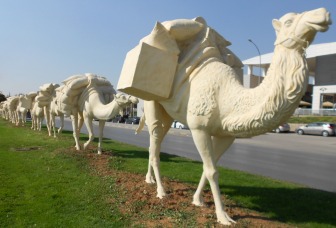Home town of the pistachio Population: 1,800,000
Old name: Ayntab
***Although Gaziantep was not as badly affected by the 2023 earthquakes as Antakya and Maraş, it nonetheless suffered damage, especially to the castle.***
Gaziantep (or Antep for short) is a town on the up. During the 1990s it was perilously close to the frontier of what was thought of as eastern Turkey where most foreigners feared to tread. At the same tine it was also one of the towns that expanded rapidly as easterners migrated west in search of a better life. The opening of the Birecik Dam in 2001 led to the flooding of the site of the wealthy Roman town of Belkis-Zeugma nearby. After archaeologists rushed to rescue what they could of the magnificent mosaics that once decorated its riverside villas, the obvious place to put them on show turned out to be Antep, which thereby received a considerable fillip in the tourism stakes.
Mention Gaziantep to a Turk and chances are that their eyes will mist over as they mutter the words çam fıstığı [pistachios]. Of course from the pistachios comes melt-in-the-mouth baklava, best sampled, perhaps, at İmam Çağdaş, a frantically busy restaurant in the bazaar, where they bake and dispatch two tons of the sticky stuff around the country every single day. Wolf yours down after a helping of spicy Adana kebap or a paper-thin lahmacun, and it should set you up for a night on the tiles in a town which offers a great deal more in the way of entertainment than you might expect.
Avoid the dubious- looking watering-holes lurking around Heykel, the landmark main square, and instead head for pedestrianised Gaziler Caddesi where a string of atmospheric café-bars with live music and quirky décor cater to a largely student clientele. Yet more cafes can be found in the narrow streets of the Bey Mahalle where many of the old houses have been restored. You’ll quickly find your own favourite. Mine is the Papirüs.
Don’t leave town without:
- Sampling Antep’s famously rich and sweet baklava made from locally-grown pistachios
- Drinking a bowl of beyran çorbası made from the rump of a sheep and flavoured with lashings of garlic
Backstory
A glance at a map reveals that Antep is only 30km from the Syrian border, a fact that has influenced its history, architecture and cuisine. Given its crossroads location, it goes almost without saying that over the centuries it was batted back and forth between the Byzantines, the Arabs, the Selçuks, the Mameuks and the Mongols, before finally falling to the Ottomans in 1516 during the reign of Selim I.
While it was ancient history that bestowed many of the specific tourist attractions on Antep, more recent history looms large too. In the early part of the 20th century, for example, there was still a sizeable Armenian community here whose legacy is the stupendous stripy churches. Then in 1920, during the Turkish War of Independence, the French invaded Antep in an attempt to carve out a fiefdom for themselves in southeastern Turkey.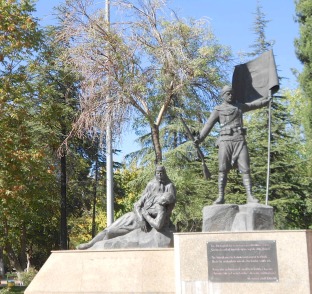 After 10 months the city was forced to capitulate (of course the end of the war saw the French driven out again), but it had put up such a determined resistance that the epithet “Gazi [Heroic]” was added to its name in perpetual commemoration.
After 10 months the city was forced to capitulate (of course the end of the war saw the French driven out again), but it had put up such a determined resistance that the epithet “Gazi [Heroic]” was added to its name in perpetual commemoration.
Around town
Where else could you start a tour of Antep but in the state-of-the-art Zeugma Museum (closed Mondays)? Here you’ll find a mind-boggling array of mosaics depicting the life and legends of the Roman era, as well as a fierce-eyed statue of Mars, the Roman god of war, that was dredged unexpectedly from the ashes of old Zeugma.
Most famous of the mosaics is a tiny fragment depicting a so-called gypsy girl. Some authorities suggest instead that it could be a representation of Alexander the Great who passed through these parts in the 4th century B.C. Whatever the truth, this headscarved, be-earringed face with the Mona Lisa look about it has become the most familiar symbol of modern Antep.
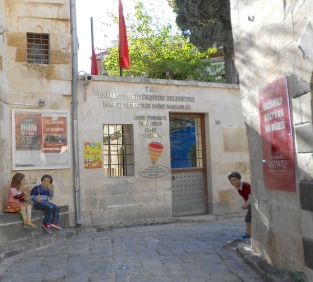 The Zeugma Museum is by far the most important museum in Antep but there are also lots of smaller museums in the back streets. Inevitably, some are much more interesting than others but one especially worth looking out for is the Toy Museum, a rare attraction actually aimed at children.
The Zeugma Museum is by far the most important museum in Antep but there are also lots of smaller museums in the back streets. Inevitably, some are much more interesting than others but one especially worth looking out for is the Toy Museum, a rare attraction actually aimed at children.
The Bayazhan complex contains Antep’s own Kent Müzesi (City Museum) as well as a restaurant and bar.
Antep’s second most important attraction was the castle which sat atop an artificial mound of earth just like its much larger but otherwise virtually identical counterpart across the Syrian border in Aleppo (Haleb). (In February 2023 the castle was extensively damaged. I have not had a chance to revisit it since,)
Around the base of the mound money had been poured into the partially successful restoration of an old hamam (Turkish bath) and the regeneration of an old coffee house with some pleasant stained glass and an inviting garden. I don’t know if they survived the quakes.
Beyond these specific attractions lies the network of streets that constitutes the bazaar, a great place to browse for old and new copper and perhaps for the odd saddle or two. 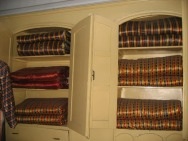 Antep produces a olourful cloth called kutnu made from silk and cottonThe bazaar area has expanded considerably as more and more of the old hans are cleaned up and found new uses. Since the posh Şirehan Hotel opened, for example, work has begun on cleaning up many contemporary 19th-century hans in the same street.
Antep produces a olourful cloth called kutnu made from silk and cottonThe bazaar area has expanded considerably as more and more of the old hans are cleaned up and found new uses. Since the posh Şirehan Hotel opened, for example, work has begun on cleaning up many contemporary 19th-century hans in the same street.
On a fleeting visit, Gaziantep can come across as a typically ugly modern town. With time on your hands, however, it’s well worth poking about its back streets, whereupon you will discover the many narrow alleyways lined with sturdy old mansions, their slightly forbidding exteriors barely hinting at the glories to be found inside.
To get an idea of what one of these mansions would have looked like in its heyday, head straight for the Hasan Süzer Museum (closed Mondays) which lies to the southwest of the main square dominated by an equestrian statue of Atatürk. In typical Antepli style, this house boasts a courtyard patterned in black and white marble with tiered living rooms opening on to it on all sides. The rooms have been restored to suggest Ottoman grandeur although what may linger most in your memory is the cave-like storage area beneath the house with its curious and unexpected echoes of Cappadocia.
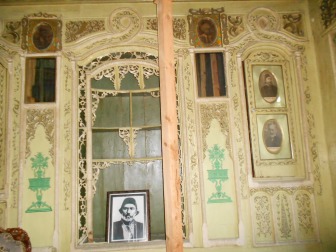 If you can afford to splash out on your accommodation, you can get to know the architecture more intimately by booking into the stylish Anadolu Evleri (Anatolian Houses) or the rather more ramshackle Belkis Han, two hotels created out of rooms clustered around stripy-floored courtyards.
If you can afford to splash out on your accommodation, you can get to know the architecture more intimately by booking into the stylish Anadolu Evleri (Anatolian Houses) or the rather more ramshackle Belkis Han, two hotels created out of rooms clustered around stripy-floored courtyards.
Several cafés have also been created inside old mansions. Finest is the Papirüs Cafe where tables are set up around a gnarled old tree in the courtyard. For some time this building actually accommodated the Iranian Trade Delegation; the upstairs rooms are a fast-fading fantasia of mirrors and frescoes crying out for conservation. (As of 2024 I’m hearing that the cafe has closed.)
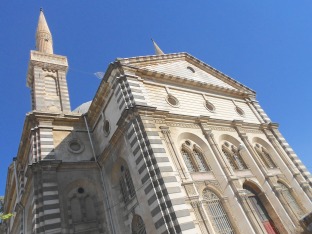 Kurtuluş CamiThe mansions aside, Antep’s other architectural gems are its mosques, some of them converted out of old churches. In a nod to Syria’s proximity, their minarets are often jauntily capped and balconied. Even more striking, however, are the bold black and white stripes that surround door and window frames, and often sweep across the mihrabs too.
Kurtuluş CamiThe mansions aside, Antep’s other architectural gems are its mosques, some of them converted out of old churches. In a nod to Syria’s proximity, their minarets are often jauntily capped and balconied. Even more striking, however, are the bold black and white stripes that surround door and window frames, and often sweep across the mihrabs too.
Most magnificent of these striped buildings was the gigantic Kurtuluş Camii (Independence Mosque), which started life as the Armenian Apostolic St Mary’s cathedral in 1892. It was designed by Sarkis Balyan, who was also responsible for many buildings in İstanbul. Alas, the quakes of 2023 brought down its dome and minarets.
Easier to find is the Kendirli Kilisesi, an Armenian Catholic edifice which dates back to 1860 but was rebuilt in 1898. It now serves as a concert hall. 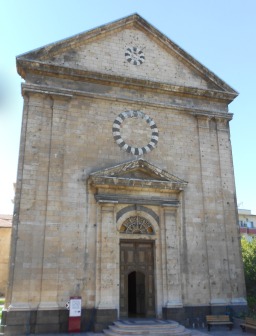 Kendirli KilisesiThe lovely 19th-century Armenian Church of St Mary has been converted into the Ömer Ersoy Cultural Centre.
Kendirli KilisesiThe lovely 19th-century Armenian Church of St Mary has been converted into the Ömer Ersoy Cultural Centre.
Sleeping
Gaziantep has lots of business-class hotels to suit all budgets and a handful of lovely boutique hotels. Unfortunately most of the older hotels still belong to the days when the designers threw all their energy into cheering up the lobby area, leaving none to spare for the bedrooms.
Belkis Han Tel: 0342-220 2020 (?)
Castle House. Tel: 0342-231 4142
Dayı Ahmet Ağa Konağı. Tel: 0342-232 1626
Ibis Hotel. Right beside the Forum Shopping Centre within walking distance of most main sights. Tel: 0342-211 0030
Novotel. Right beside the Forum Shopping Centre within walking distance of most main sights. Tel: 0342-211 0000
Şirehan Hotel. Tel: 0342-221 0011
Transport info
There are daily flights from İstanbul to Gaziantep as well as buses from Ankara and most major towns in the vicinity. You can even get here from Adana by train. Gaziantep Oğuzeli Airport (GZT) is 20km south of the town centre.
Within town many buses leave from near the square with the big statue of Atatürk usually known as Heykel. The bus stop itself is called Balıklı (Fishy) despite there being not the slightest sign of any fish. It’s a pretty chaotic spot although someone will probably help you find the bus or dolmuş you need.
You need to have bought a ticket before boarding the bus. Tickets are on sale in some büfes including the one in front of the bus terminal and in Balıklı square – stock up in case there’s nowhere to buy one when you want to return.
Minibuses to Birecik, Maraş, Nizip and Urfa leave from the main otogar. To get to Düllük take the Beylerbeyi bus from Balıklı.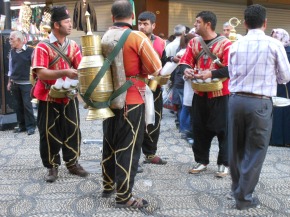 Sellers of meyankökü şerbeti (licorice drink) mass on Gazi Caddesi
Sellers of meyankökü şerbeti (licorice drink) mass on Gazi Caddesi
Antep’s expanding suburban rail service, Gaziray is connected to the station (Gar).
Day trip destinations
Araban
Images of Gaziantep’s colourful mosques: https://www.facebook.com/media/set/?set=a.290849551082284.1073741862.137912259709348&type=1
